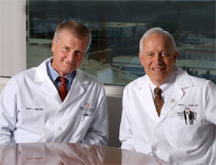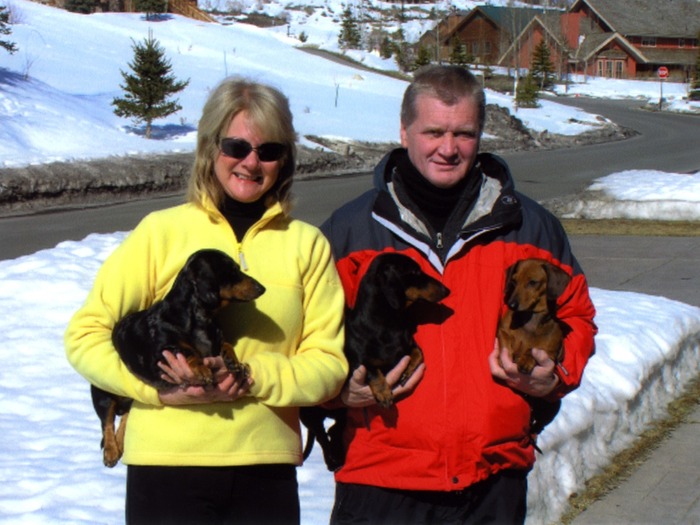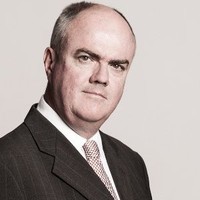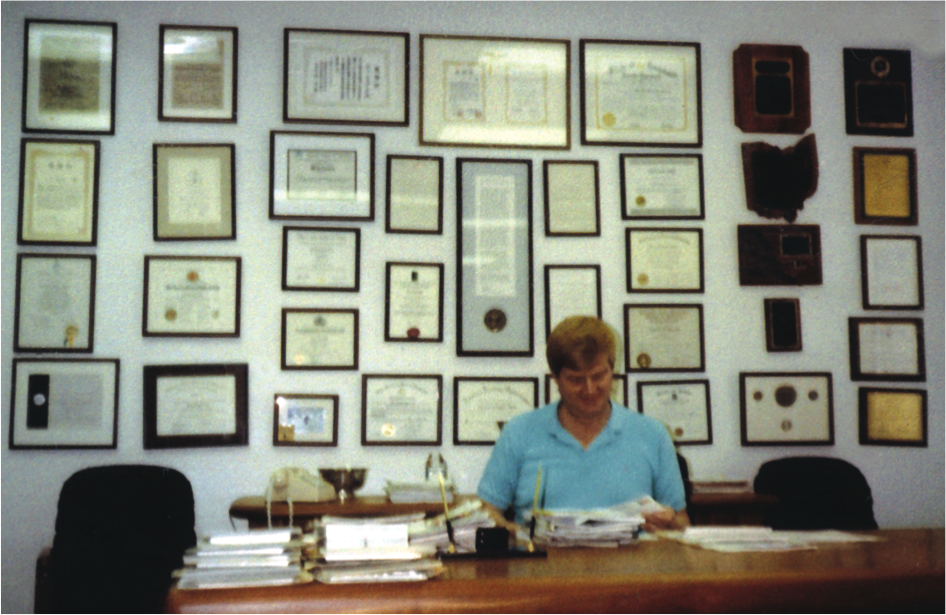Heidelberg 14 September 2021. Today would be the 80th birthday of David Joseph Apple, MD (14 September 1941, to 18 August 2011). He was the founder of our laboratory and above all he was a pioneer in IOL research and ophthalmic pathology. He was also a medical historian and the biographer of Sir Harold Ridley (1906 to 2001), the inventor of the intraocular lens (IOL). David Apple died on the afternoon of 18 August 2011, in Charleston, SC.
###
 Without David Apple’s work, it is fair to say that Sir Harold Ridley’s place as the IOL inventor, the date of the first implantation of an IOL and the circumstances leading to the development of that first lens - all that would be obscured and forgotten. But David did more than verify and document Ridley’s life; he set out to improve the world that Ridley’s invention had changed… David Apple devoted his career to studying intraocular lenses and rescuing the reputation of their inventor.
Without David Apple’s work, it is fair to say that Sir Harold Ridley’s place as the IOL inventor, the date of the first implantation of an IOL and the circumstances leading to the development of that first lens - all that would be obscured and forgotten. But David did more than verify and document Ridley’s life; he set out to improve the world that Ridley’s invention had changed… David Apple devoted his career to studying intraocular lenses and rescuing the reputation of their inventor.
He often stated that Harold Ridley changed the world. What we can say about David Apple is that he vastly improved the world that Harold Ridley changed –_ I. Howard Fine MD, 2011
{: {: .pic-right}Born in Alton, Illinois, on 14 September 1941, to Joseph and Margaret Bearden Apple, David Apple graduated in 1959 from the East Alton-Wood River High School in Wood River, Illinois. He studied pre-med at Northwestern University and went on to the University of Illinois College of Medicine, serving his internship and residency in Pathology at Louisiana State University. In 1980 he completed his residency in ophthalmology at the University of Iowa. He was Assistant and subsequently Associate Professor of Ophthalmology under Morton F. Goldberg, MD, at the University of Illinois Eye and Ear Infirmary and Abraham Lincoln School of Medicine in Chicago from 1971 to 1975. He completed his residency in Clinical Ophthalmology under Frederick C. Blodi, MD, at the University of Iowa in 1979.
{: .pic-right}Born in Alton, Illinois, on 14 September 1941, to Joseph and Margaret Bearden Apple, David Apple graduated in 1959 from the East Alton-Wood River High School in Wood River, Illinois. He studied pre-med at Northwestern University and went on to the University of Illinois College of Medicine, serving his internship and residency in Pathology at Louisiana State University. In 1980 he completed his residency in ophthalmology at the University of Iowa. He was Assistant and subsequently Associate Professor of Ophthalmology under Morton F. Goldberg, MD, at the University of Illinois Eye and Ear Infirmary and Abraham Lincoln School of Medicine in Chicago from 1971 to 1975. He completed his residency in Clinical Ophthalmology under Frederick C. Blodi, MD, at the University of Iowa in 1979.
“Implantology”
 In 1980 he joined Dr Randal Olson’s group at the University of Utah, Salt Lake City. Together with Dr Olson, he founded the Center for Intraocular Lens Research in Salt Lake City. During the 1980’s he and his colleagues established a reputation and high standard for the new science of what he termed “implantology”, research on the pathology of IOL complications. He became a world-renowned expert in IOL pathology, cataract surgery, intraocular lens (IOL) implantation and refractive surgery.
In 1980 he joined Dr Randal Olson’s group at the University of Utah, Salt Lake City. Together with Dr Olson, he founded the Center for Intraocular Lens Research in Salt Lake City. During the 1980’s he and his colleagues established a reputation and high standard for the new science of what he termed “implantology”, research on the pathology of IOL complications. He became a world-renowned expert in IOL pathology, cataract surgery, intraocular lens (IOL) implantation and refractive surgery.
He moved to South Carolina in 1988 to become Professor of Ophthalmology and Pathology, Professor and Chairman at the Storm Eye Institute of the Medical University of South Carolina in Charleston. He held the Pawek-Vallotton Chair of Biomedical Engineering and was Director of the Center for Research on Ocular Therapeutics and Biodevices until 2002. During his Chairmanship of the Department of Ophthalmology in Charleston from 1988 to 1996, he successfully led the effort to raise $8.8 million to complete a three-floor expansion and general renovation of the Eye Institute.
Charleston and WHO
His laboratory in Charleston (and at later sites: Salt Lake City, Sullivan’s Island and Heidelberg) became an official Collaborating Center of the World Health Organisation’s Prevention of Blindness Programme. His meeting with WHO Programme director Dr Bjorn Thylefors of the Prevent Blindness Division was instrumental in providing information to WHO on which type of IOL should be used in cataract surgery in developing countries.
Back to Utah
He returned to Utah in 2002 and transferred his Center for Intraocular Lens Research back to Salt Lake City, Utah: the city where he had begun his career in the field of ocular bioengineering.
In 1998 he became the only American to have been selected to give the European Guest Lecture at the respected Oxford Ophthalmological Congress, held annually at the University of Oxford. He received the Senior Honor Award from the American Academy of Ophthalmology (AAO) in San Diego, California.
Ann and David
 Those who remember meeting David will also remember his soulmate Ann. David married Ann Addlestone in 1995 and became stepfather to Scott E. Kabat and Jacqueline B. Kabat.
Those who remember meeting David will also remember his soulmate Ann. David married Ann Addlestone in 1995 and became stepfather to Scott E. Kabat and Jacqueline B. Kabat.
Through his late brother Robert’s family, David had a nephew: Lee Apple and two nieces: Raina Apple and Dione Apple.
In the late 1990s, he developed (self-diagnosed – correctly) metastatic cancer at the base of his tongue.) Between 1999 and 2011, he had numerous bouts of pneumonia and was frequently hospitalised – most seriously with a cerebral vascular stroke two years after moving to Salt Lake City. In all of this, Ann was constantly at his side and helped him through years of pain and illness.
In a tribute, I. Howard Fine MD of Eugene, Oregon, wrote affectionately of his friends, David and Ann
“David was a good friend and a delightful person with a subtle sense of humour. He had a passion for history, especially the history of science, the Civil War, and music. He liked to inform ophthalmologists that Johann Sebastian Bach died shortly after his health began to deteriorate as a result of a botched cataract surgery by an itinerant surgeon. David reminded us that the first hostilities of the Civil War took place in Charleston, his home, with the Confederate bombardment of Fort Sumter. He had an enormous corpus of knowledge and was a great lover of music. While living in Charleston, he served on the boards of the Charleston Symphony and the Charleston Ballet and was active in Chamber Music Charleston. He was pleased that his home was the model for one of the houses on Catfish Row, the stage setting for the American opera “Porgy and Bess.” He loved to travel, was fluent in German, and had a special affection for his dachshunds. His wife, Ann, was the love of his life and a favourite of their friends throughout the world. A few years after their marriage, David was diagnosed with a malignancy, which required surgery, chemotherapy, and radiation therapy. Ann nurtured, maintained, and cared for him magnificently over the ensuing years as he dealt with the chronic pain and the terrible side effects of his surgery and anti-cancer treatments.”
Music and Germany
Besides ophthalmology, Dr Apple was passionate about classical music – he served on the Board of the Charleston Symphony, the Board of the Charleston Ballet Theatre and was active in Chamber Music Charleston. He was an amateur military historian, specialising in World War II and the US Civil War.
Gerd Auffarth, Professor of Ophthalmology at Heidelberg University, traces his interest in ophthalmic research back to the two years he spent in Charleston at the Medical University of South Carolina as a research fellow in Prof. Apple’s lab.
“David’s Apple Korps, as David liked to call his research fellows, are nowadays scattered throughout the world: the Heads of prestigious ophthalmic departments, top-ranking surgeons, editors of respected medical journals and medical advisors to the ophthalmic device industry. He mentored us in how we carry out ophthalmic research, always respecting the patient and looking for optimum clinical outcomes, trusting only in the laboratory and clinical evidence on the safety and efficacy of new IOLs and new techniques. He taught us to value the courage and innovation of the IOL pioneers. We owe so much to David.”
Further reading
Apple, David J (2006). Sir Harold Ridley and his fight for sight. Thorofare, NJ. SLACK Incorporated. ISBN 1-55642-786-7
David J Apple entry in Wikipedia.com
 Donald Munro
Donald Munro 
 Singapore winner!
Singapore winner!